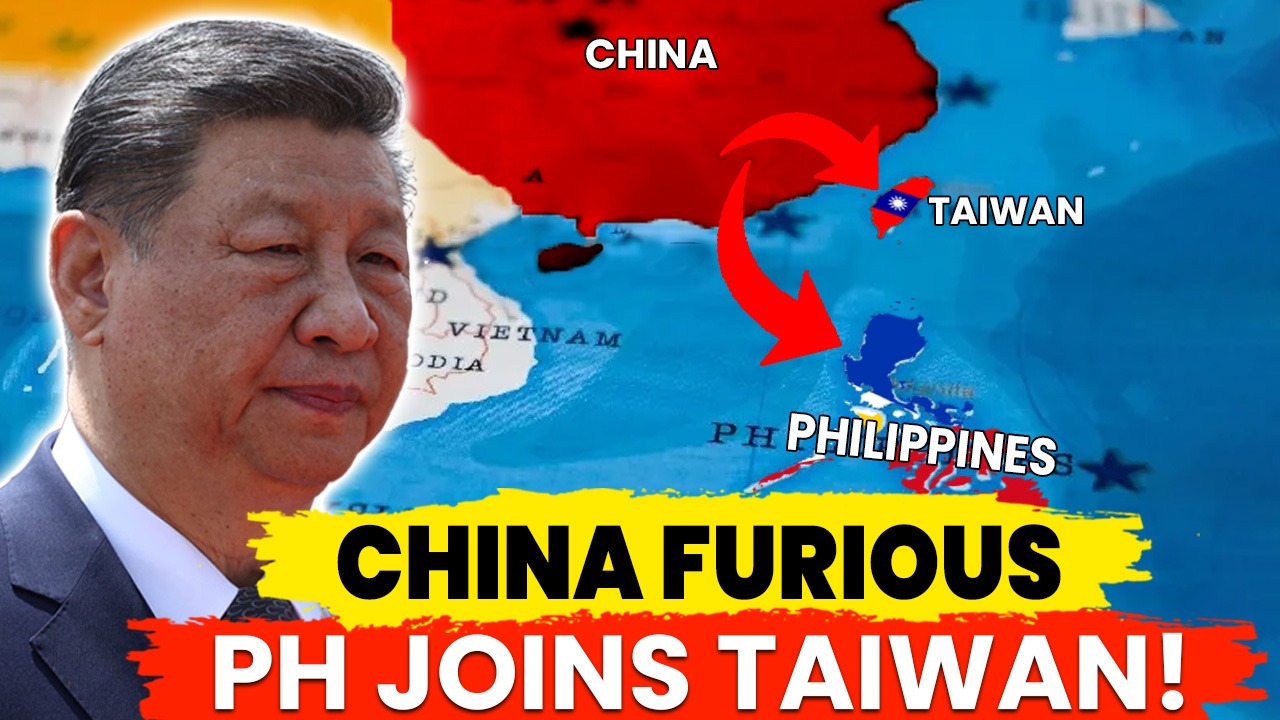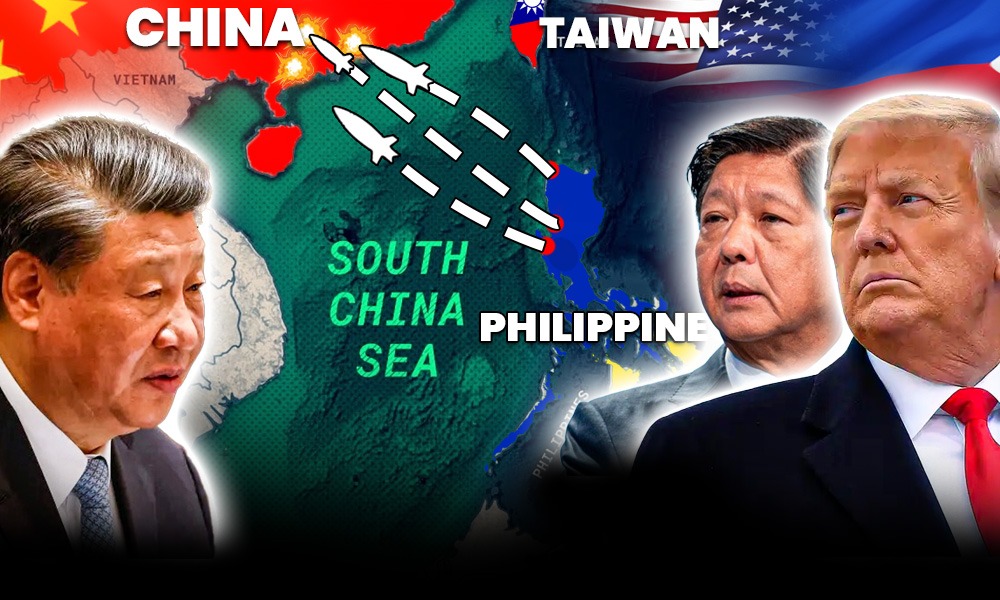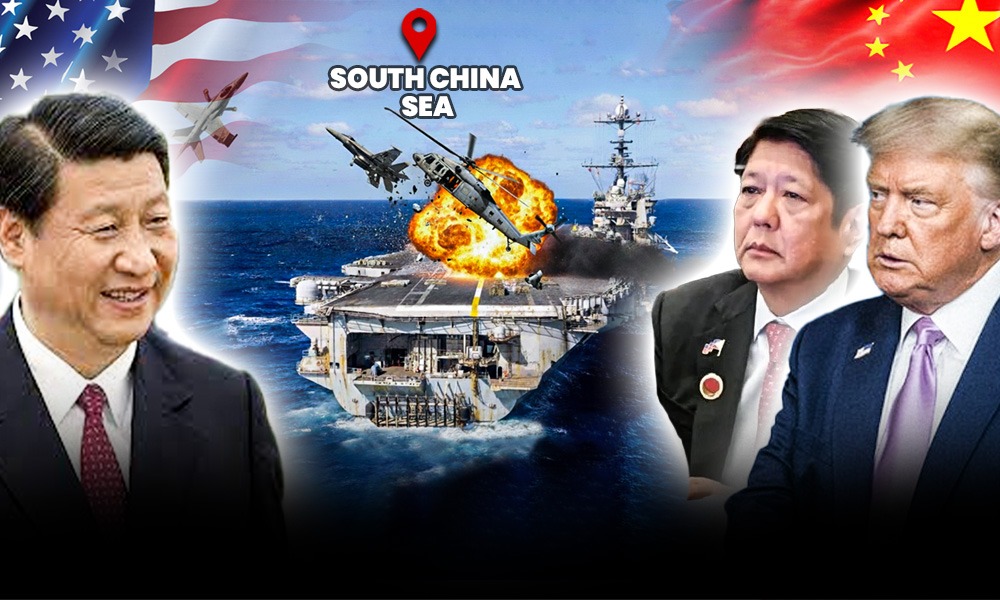If there’s a storm brewing in Southeast Asia, Palawan might just be at the center of it. To most of the world, Palawan is a slice of tropical heaven, crystal-clear waters, limestone cliffs, and coral reefs teeming with marine life. But beneath the surface of this serene island lies one of the most dangerously strategic locations on Earth. And right now, the world’s two biggest powers, the United States and China are eyeing it with increasing intensity.
Why does Palawan matter so much? Because it sits at the edge of the South China Sea, one of the most contested and critical maritime zones in the world. Over $3.36 trillion in global trade passes through these waters every year, carrying everything from oil to electronics. Whoever controls this sea lane doesn’t just influence trade, they influence the global economy. And Palawan is a front-row seat to that high-stakes game.
Just off Palawan’s western coast lie some of the region’s most sensitive flashpoints: Second Thomas Shoal, Scarborough Shoal, and Sabina Shoal, all within the Philippines’ Exclusive Economic Zone (EEZ). Yet China claims almost all of the South China Sea under its controversial Nine-Dash Line, a claim dismissed by international law but still aggressively enforced by China’s growing maritime presence. Chinese coast guard ships, “fishing” vessels, and even naval assets have been spotted repeatedly in Philippine waters, pressuring local fishermen, blocking military missions, and slowly creeping closer to Palawan’s shores.
At the same time, China has turned over 3,200 acres of submerged reefs into militarized artificial islands, equipped with airstrips, radar systems, missile silos, and deepwater ports. This isn’t just about defending territory, it’s about projecting power. And it’s happening alarmingly close to Palawan.
But China isn’t the only one making moves. In 2025, the United States and the Philippines strengthened their long-standing alliance under the Enhanced Defense Cooperation Agreement (EDCA). One of the new access points granted to U.S. forces? A military base in Palawan. That’s no coincidence. The U.S. sees Palawan as a key launching point for regional deterrence, freedom of navigation patrols, and rapid response in the event of conflict. It’s no longer just about presence, it’s about positioning.
Beneath the waves near Palawan also lie massive untapped reserves of oil and gas, with some estimates suggesting up to 11 billion barrels of oil and 190 trillion cubic feet of natural gas. Add to that some of the world’s richest fishing grounds, and you start to understand why this region is being so fiercely contested. For local fishermen in Palawan, it’s no longer about making a living,it’s about navigating through waters filled with foreign patrols and unspoken threats. “We used to fish near Scarborough,” one fisherman said in a recent interview. “Now we’re scared. They’re there with big ships, watching us.”
For everyday Filipinos, the geopolitical chess match playing out off their shores isn’t just theoretical, it’s real. Tensions at Second Thomas Shoal flared up again in May 2025 when Philippine forces clashed verbally with Chinese vessels shadowing a resupply mission to the BRP Sierra Madre, an old navy ship beached there to assert the Philippines’ presence. These aren’t isolated events, they’re warning signs. Every encounter, every blocked boat, every radar ping adds another drop of pressure to a pot that’s already boiling.
So what does the future hold? Will the Philippines double down on its alliance with the U.S., or seek a more diplomatic path with China? Will the South China Sea remain a tense stalemate, or will a single miscalculation turn this into the next major global conflict?
One thing is certain: Palawan is no longer just a paradise, it’s a flashpoint. And the world needs to start paying attention.
Palawan Heats Up: Military Moves and Rising Danger in the South China Sea
Tensions in the South China Sea aren’t just simmering anymore, they’re boiling. And Palawan, once known purely for its serenity, is now caught in the rising tide of military buildup and geopolitical friction. The stakes? Sovereignty, security, and survival.
Let’s start with the moves being made on the ground. Under the Enhanced Defense Cooperation Agreement (EDCA), the United States has dramatically deepened its military partnership with the Philippines. As of 2025, nine Philippine military bases are now open to U.S. forces, including strategic locations in the north (facing Taiwan), the south, and Palawan, the closest outpost to key flashpoints like Second Thomas Shoal and Scarborough Shoal.
But it doesn’t stop there.
In a bold step, the U.S. has announced plans to build a specialized maritime facility in Quezon, Palawan, just about 160 miles east of Second Thomas Shoal. Designed to host watercraft and assault boats, this installation will enhance the Philippines’ capability to monitor and respond to Chinese activity in the disputed waters. The project is set to be operational by early 2026, funded by the U.S. under EDCA, not as a base, but as a logistical and maintenance support hub for Philippine vessels. The U.S. Embassy emphasized the nature of this cooperation, stating: “Our US-Philippine alliance, with its roots in the 1951 Mutual Defense Treaty, remains a cornerstone of peace and security, promoting our common vision for a free, open, and resilient Indo-Pacific. All of our military activities in the Philippines are done in full coordination with our Philippine allies.” This isn’t just rhetoric. It’s a direct message to Beijing.
China’s Aggressive Push: “Gray Zone” Tactics Turn Red
While the Philippines and the U.S. ramp up cooperation, China continues to assert near-total control over the South China Sea, backing its sweeping “nine-dash line” claims with brute force, even though the 2016 Hague tribunal flatly rejected them under international law.
By 2023, China had reclaimed over five square miles of land, turning submerged reefs into heavily fortified islands, some equipped with runways, radar systems, and long-range missiles. These outposts serve as permanent military platforms, strategically placed right near Palawan’s waters.
On the seas, Chinese tactics have grown increasingly aggressive. Around Second Thomas Shoal, where the BRP Sierra Madre, a rusty World War II-era Philippine ship grounded in 1999, serves as a makeshift outpost, Chinese ships have repeatedly rammed Filipino vessels, fired water cannons, and even used military-grade lasers to blind crews. But it’s not just intimidation anymore.
In a shocking June 2024 incident, Chinese Coast Guard personnel reportedly boarded a Philippine Navy boat, assaulted Filipino marines, smashed communication gear, and left one soldier permanently injured, losing a thumb. The video of the aftermath spread rapidly, igniting public outrage across the Philippines and renewing urgent debates over what happens if, or when someone is killed.
The Treaty That Could Trigger a War
Enter the 1951 Mutual Defense Treaty between the U.S. and the Philippines. According to this agreement, if a Filipino service member is killed in the line of duty due to foreign aggression, it could trigger automatic U.S. military support, potentially plunging Washington into a direct confrontation with Beijing. This isn’t some dusty Cold War document. It’s very much alive. And as incidents multiply, so do the chances of a deadly misstep.
In fact, both U.S. and Philippine officials have reaffirmed that the treaty now explicitly covers attacks in the South China Sea, including those on Philippine public vessels, aircraft, and armed forces. Which means: one fatal skirmish at Second Thomas Shoal could unleash the biggest military conflict the region has seen in decades.
Palawan: Paradise Under Pressure
All eyes are now on Palawan, once a peaceful tourist gem, now a nerve center for U.S. operations and a forward base for Filipino maritime patrols. The construction in Quezon, the joint military drills, and the persistent threats from Chinese vessels, this is no longer theoretical. It’s happening. The big question: How far will China go to assert control? And how far will the U.S. and Philippines go to push back? The world may not want war, but Palawan is standing in a place where peace, power, and pride collide.
Who Really Owns Palawan? History Says It Loud and Clear
In the heart of the South China Sea dispute, one question keeps surfacing: Whose waters are these, really? To understand the rising tension around Palawan today, we have to zoom out, not just geographically, but historically. Because the truth is this: Palawan has always been Filipino. And the history books agree.
The Philippines’ sovereignty over Palawan dates back centuries, as early as 1690, when Spanish colonial records and maps marked the archipelago, including Palawan, as a governed part of the Spanish East Indies. Over time, as the Philippines transitioned through Spanish, American, and then independent rule, Palawan remained firmly within the nation’s territory.
In 2016, the world weighed in. A landmark United Nations Convention on the Law of the Sea (UNCLOS) Arbitral Tribunal ruled that Second Thomas Shoal, Mischief Reef, and Reed Bank—all within striking distance of Palawan, fall squarely within the Philippines’ Exclusive Economic Zone (EEZ). That means only the Philippines has the right to explore, extract, and protect the natural resources there.
The National Historical Commission of the Philippines (NHCP) couldn’t have been more direct. “Palawan is and will always be Filipino,” said the NHCP in a 2025 statement. “The historical fact clearly and convincingly shows that the Philippines and its predecessor state actors have always exercised sovereignty over our archipelago and over Palawan in particular. No other state contests this fact. Not one. This has been accepted by the international community for more than a century.”
That’s not just rhetoric, it’s backed by legal rulings, diplomatic consensus, and historical documentation. But not everyone is accepting that reality.
China’s Claim: A Story Without a Chapter
Despite the global consensus, China continues to push sweeping claims over nearly the entire South China Sea, including waters well within the Philippines’ EEZ. The so-called “nine-dash line” that Beijing uses to justify its position has no basis in international law. It was thrown out by the 2016 UNCLOS tribunal. But Beijing refuses to back down.
Even more puzzling, some Chinese social media narratives have begun circulating wild historical theories, suggesting that Palawan was once called “Zheng He Island,” allegedly named after the famed 15th-century Chinese admiral. According to these viral claims, Palawan was historically part of China. But Philippine scholars have had enough.
Leading historians quickly dismantled the story, stating there is no credible historical record, Chinese, Filipino, or otherwise, showing Zheng He ever sailed into Palawan’s waters. No ports, no settlements, no sustained interactions. It’s a myth. A meme turned into a political talking point. As one Filipino historian put it bluntly: “You can’t rewrite history based on TikToks and Weibo threads.”
Second Thomas Shoal Resupply Mission: Did Manila Ask Beijing?
The U.S. Has Been Here Before — And Now, It’s Back
Interestingly, Palawan has also played a strategic role for the United States, long before today’s rising tensions. Back in 1945, as World War II neared its end, the U.S. established Naval Base Puerto Princesa in Palawan to support Allied operations. That base would later close, and by 1991, the U.S. was largely out of the Philippines after the Senate rejected a renewed base agreement. But the tides have turned.
With the Enhanced Defense Cooperation Agreement (EDCA) now in full swing, the U.S. is once again back in Palawan, not as a colonizer, but as an ally, helping the Philippines defend its legally recognized territory in the face of increasing Chinese pressure. Unlike the past, today’s cooperation is Philippine-led, transparent, and bounded by mutual respect and sovereignty.
History Is Not on China’s Side
When it comes to the South China Sea and Palawan, China’s claims may be loud, but they’re not legal, and they’re not historical. The Philippines has international law, historical record, and diplomatic backing on its side. And with growing U.S. military support and local awareness, Palawan is no longer just a battleground of reefs and shoals, it’s a symbol of national identity. The real question now: How far will China go to challenge not just territory, but the very truth of history itself?
Billions in Limbo: How Tensions Are Freezing the Philippines’ Energy Future
For all the warships, coast guard stand-offs, and political posturing in the South China Sea, the real price of this conflict may not come in bullets but in billions of pesos lost in economic opportunity. At the heart of it is energy.
Just off the coast of Palawan, beneath the choppy waters where Philippine and Chinese vessels play cat-and-mouse, lies one of the richest untapped sources of oil and gas in Southeast Asia. We’re talking about the Reed Bank and surrounding seabed, which could hold up to 11 billion barrels of oil and 190 trillion cubic feet of natural gas. That’s enough to transform the Philippines from a fuel importer to a regional energy player.But there’s a problem: nobody wants to invest in a battlefield.
Despite the Philippines’ legal rights under international law to explore these resources, investors are backing off, spooked by escalating tensions with China. Even planned joint ventures have stalled. Seismic surveys, exploration missions, and infrastructure development have all been postponed, sometimes indefinitely. As Energy Secretary Sharon S. Garin bluntly put it: “No investor will risk millions or billions of pesos when they are not sure if they are secure.”
And she’s right. Who’s going to spend billions to drill for gas when Chinese ships are circling the rigs? When supply boats could be rammed or blocked? When construction crews might be operating under the threat of water cannons or worse?
This uncertainty doesn’t just hurt big corporations. It hurts Filipino energy independence. It means higher electricity bills, imported fuel, and a missed chance at economic transformation, especially for energy-hungry islands like Palawan.
A Future on Hold
What could have been a golden age for offshore energy is instead turning into a story of missed opportunities and paralyzed development. The Philippines stands ready to drill, but it can’t do it alone, not without global investment, regional support, and most importantly, security in its own waters. The South China Sea isn’t just a geopolitical chessboard, it’s a frozen pipeline of progress. And until the tensions cool, the Philippines’ energy future will remain just out of reach, buried not just under water, but under risk.
Palawan: The Calm Island at the Center of a Coming Storm
At first glance, Palawan is all about turquoise waters, white beaches, and postcard beauty. But behind the palm trees lies something much bigger: a strategic flashpoint in the rising rivalry between the United States and China.
Sitting on the western edge of the Philippines, Palawan faces the South China Sea, a region through which over $3 trillion in global trade flows every year, and beneath which lie vast reserves of oil and gas. But this isn’t just about trade or resources anymore, it’s about power, sovereignty, and survival. With the Enhanced Defense Cooperation Agreement (EDCA) now fully operational, the U.S. has boots closer to the front, building new facilities in Palawan to support the Philippines. Washington calls it cooperation. Beijing calls it provocation.
Meanwhile, China continues its relentless push, turning reefs into fortified islands and backing up its illegal nine-dash line claims with coast guard ships, water cannons, and brute intimidation tactics. Incidents around Second Thomas Shoal are no longer rare, they’re routine. And every confrontation raises the stakes of triggering the 1951 Mutual Defense Treaty between the U.S. and the Philippines. For Manila, this isn’t just a geopolitical chess game. It’s about defending its sovereign waters, its people, and its future. International law is clear, the Philippines has the right. But rights mean little without the ability to enforce them.
And let’s not forget the economic price. Energy projects near Palawan are stalled. Billions of pesos in potential revenue are frozen. Investors are walking away, not because there’s no opportunity, but because there’s no security. In the bigger picture, Palawan represents more than just a few contested shoals. It’s a test case for the Indo-Pacific’s future. Will it be ruled by force, or by law? Will small nations be able to assert their rights, or be steamrolled by great powers?
Because as tensions rise, one thing is clear: Palawan may look like paradise, but right now, it’s standing on the front line of a storm that could shake the entire region.



